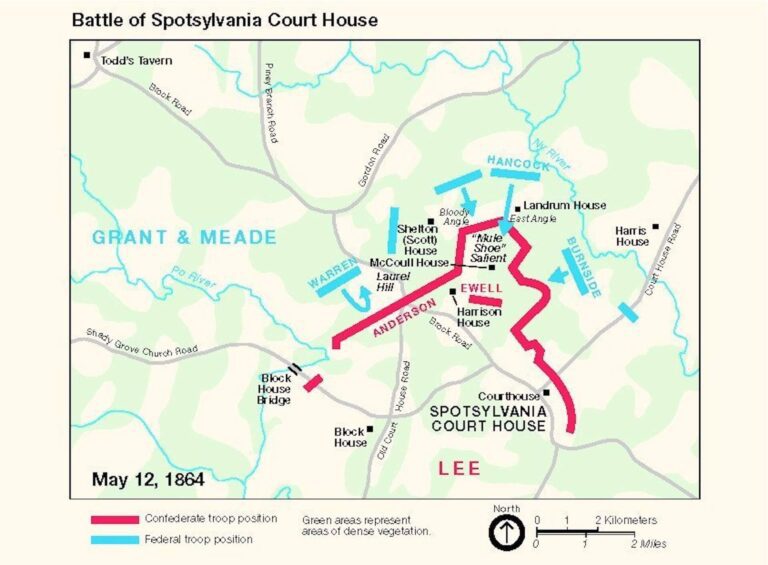Located in the city of Fredericksburg and surrounding Spotsylvania County in Central Virginia, the Fredericksburg and Spotsylvania National Battlefield Park preserves the sites of four major American Civil War battles: Fredericksburg, Chancellorsville, the Wilderness, and Spotsylvania Court House.
Covering over 8,000 acres, it is the second-largest military park in the world. The park features numerous historical sites and monuments commemorating these significant battles.
Read on to learn more, or book yourself a Civil War Battlefield Tour in Virginia.
One of the notable battles of the American Civil War was the second battle in General Ulysses S. Grant’s Overland Campaign. Known for General Robert E. Lee’s “Mule Shoe” defenses, this two-week battle saw intense hand-to-hand combat at the Bloody Angle.
On May 7, 1864, after two days of fierce but inconclusive fighting in the Wilderness, General Grant decided to disengage and move southeast. His strategy was to reach Spotsylvania Court House, outmaneuver Lee, and engage him in an open battle, leveraging his numerical superiority.
From May 7-8, 1864, Confederate cavalry engaged in a delaying action that allowed General Lee’s army to reach and block the road to Spotsylvania Court House ahead of Grant. As both sides were entrenched, they constructed extensive networks of defensive earthworks.
The Confederates established a significant salient in their lines, nicknamed the “Mule Shoe” for its shape and robust defense, which included a vast array of trenches and artillery placements reminiscent of those seen in World War I.
An initial breach of the Mule Shoe by a daring charge led by U.S. Colonel Emory Upton on May 10, 1864, demonstrated that the rebel salient was not impregnable.
In the early morning of May 12, 1864, a massive onslaught of Union soldiers attacked the Mule Shoe in the rain, creating a significant breach and gaining substantial ground against its defenders. A fierce Confederate counterattack followed, resulting in 22 hours of relentless hand-to-hand combat.
As both sides clashed over the muddy and blood-stained earthworks, the most intense and chaotic fighting occurred at a section of the line known as the Bloody Angle. After midnight, General Lee established a final defensive line, ending the gruesome battle. Subsequent fighting ensued after days of heavy rain, as General Grant sought vulnerable points in the Confederate-held line but failed to gain any significant advantage.
On May 21, 1864, after failing to break the stalemate, General Grant decided to withdraw and move southeast, closer to Richmond. Days earlier, he had communicated to Washington, stating, “I propose to fight it out on this line if it takes all summer.”
Ready to take your exploration of American Civil War history to another level? Book a guided Battlefield Tour in Virginia.

Ready to explore the battlefield for yourself? Browse our full selection of American Civil War Battlefield Tours.
Please contact us if you have any questions about our tours or services.